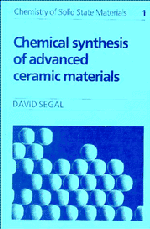Book contents
- Frontmatter
- Contents
- Preface
- Symbols
- 1 Introduction: the variety of ceramic systems
- 2 Conventional routes to ceramics
- 3 Ceramic fabrication
- 4 Sol–gel processing of colloids
- 5 Sol–gel processing of metal–organic compounds
- 6 Non-aqueous liquid-phase reactions
- 7 Polymer Pyrolysis
- 8 Hydrothermal synthesis of ceramic powders
- 9 Gas-phase reactions
- 10 Miscellaneous synthetic routes to ceramic materials
- Appendix: Determination of particle size
- References
- Index
- Frontmatter
- Contents
- Preface
- Symbols
- 1 Introduction: the variety of ceramic systems
- 2 Conventional routes to ceramics
- 3 Ceramic fabrication
- 4 Sol–gel processing of colloids
- 5 Sol–gel processing of metal–organic compounds
- 6 Non-aqueous liquid-phase reactions
- 7 Polymer Pyrolysis
- 8 Hydrothermal synthesis of ceramic powders
- 9 Gas-phase reactions
- 10 Miscellaneous synthetic routes to ceramic materials
- Appendix: Determination of particle size
- References
- Index
Summary
Introduction
Formation of polymeric cationic species in aqueous colloidal dispersions was described in section 4.4, while polymers obtained in hydrolysed tetraethyl silicate solutions have been referred to in section 5.5. The contents of this chapter, however, are concerned with synthesis and properties of polymeric ceramic precursors derived from chlorosilanes, namely polysilanes, polycarbosilanes and polysilazanes, together with their conversion, on pyrolysis, to ceramics mainly in the form of fibres and coatings on both the laboratory and industrial scale. This work, which lies at the organic–inorganic interface, illustrates the contribution that different branches of chemistry have made to ceramic synthesis, and also how an area of organosilicon chemistry, not immediately associated with ceramics, can make a significant impact on materials preparation.
Synthesis of polysilanes
Unlike conventional organic polymers, such as polystyrene, which contain a chain of carbon atoms or silicones consisting of alternating Si and O atoms, the polymer backbone in polysilanes comprises Si–Si link-ages (figure 7.1). Early work on aryl-substituted polysilanes was reported by Kipping and co-workers in a series of publications during the 1920s. As an example, diphenyldichlorosilane, (C6H5)2SiCl2, was reacted (Kipping & Sands, 1921) with molten sodium in an inert solvent, xylene, and several products were obtained. These included a sparingly soluble solid, Si4(C6H5)8, which they called an unsaturated compound and the major product, a soluble material with the same formula and referred to as a saturated compound; solvent evaporation left a resinous mass from the latter.
- Type
- Chapter
- Information
- Chemical Synthesis of Advanced Ceramic Materials , pp. 99 - 113Publisher: Cambridge University PressPrint publication year: 1989

